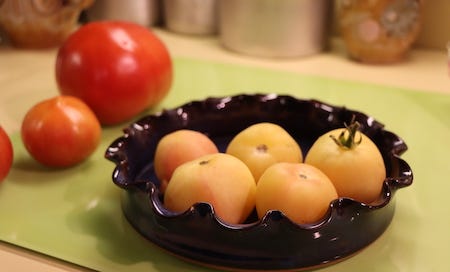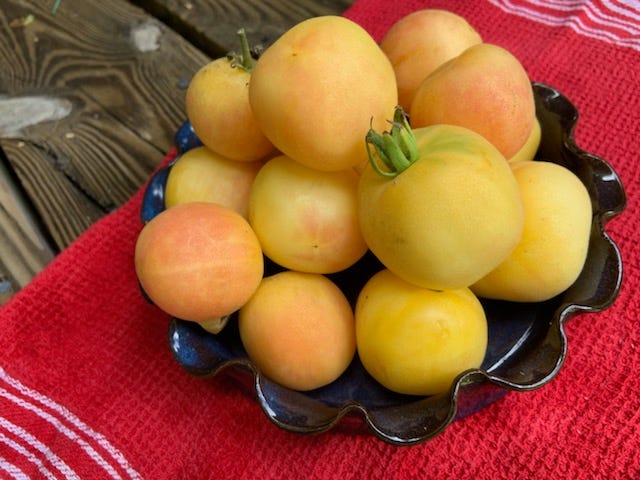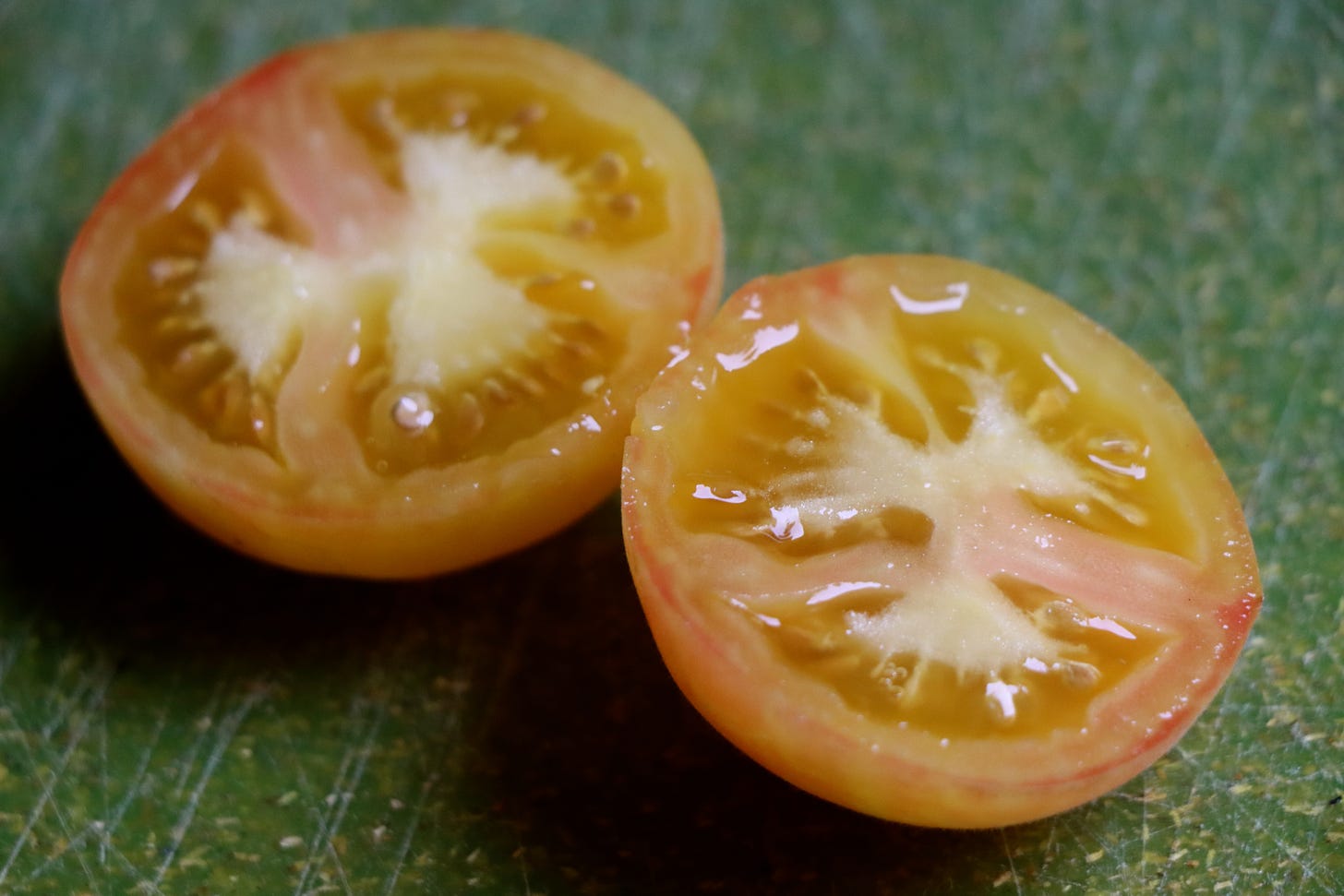Not so long ago, people were afraid of tomatoes. The ancestor plants of our cultivated tomato, Solanum lycopersicum, originated in northwestern South America, where they were not eaten, but their seeds eventually travelled to Mexico where the plants were domesticated and happily consumed by the Aztec people.
The tomato we know is thus a North American native and a member of the nightshade family, which gave some Europeans pause when the fruit was introduced by explorers returning to the “Old World” with samples. As a relative to the deadly nightshade plant known as Belladonna or Devil’s Cherries, the tomato was suspected to be poisonous, even though potatoes and eggplant are also members of the nightshade family.
According to K. Annabelle Smith, writing in Smithsonianmag.com, “A nickname for the fruit was the ‘poison apple’ because it was thought that aristocrats got sick and died after eating them, but the truth of the matter was that wealthy Europeans used pewter plates, which were high in lead content. Because tomatoes are so high in acidity, when placed on this particular tableware, the fruit would leach lead from the plate, resulting in many deaths from lead poisoning. No one made this connection between plate and poison at the time; the tomato was picked as the culprit.”
Size of maters matters
Other myths portrayed tomatoes as a potential aphrodisiac, which apparently gave some Victorians pause. In the fledgling United States, gardeners who encountered the vivid and menacing tomato horn worm also created stories of an exaggerated threat and reason to avoid the tomato itself.
By contrast, Spanish and Italian chefs did not hold back from using tomatoes which they grew and canned on a large scale beginning in the 1830s, just as recipes using the fruit also began circulating haphazardly in this county.
By 1880 when pizza was invented in Naples, the tomato’s popularity accelerated in Europe. Around the same time, Henry J. Heinz of Pittsburg created his ripe red tomato ketchup recipe using pectin rather than harmful benzoates as a preservative. Heinz thus transformed the nascent ketchup industry, selling five million bottles of his brand by 1905. In the same era, Joseph Campbell’s company introduced condensed tomato soup in a can in 1897. As the authors of The Oxford Companion to Food put it, “the tomato has come up to the front from almost nowhere in two centuries” and “has proved to have astonishingly vigorous penetrative qualities, so that it is as close to being ubiquitous in the kitchens of the world as any plant food.”
We North Carolinians can be proud to claim that the first known reference to tomatoes in the North American colonies came from herbalist William Salmon’s Botanologia, printed in 1710. Salmon noted that tomatoes were already being grown and consumed in the Carolinas--long before pizza, ketchup, or Campbell’s soup had become an entrepreneurial dream.
As might be expected, the native peoples in our region were likely way ahead of the colonists, however. The Cherokee purple tomato--so named and popularized by a tomato collector and retired chemist, Craig LeHoullier of Raleigh—may be older than we can know. LeHoullier first received seeds of the plant in the mail from a grower in Tennessee in 1990. The sender claimed this heirloom variety had been passed down through a neighbor’s family for more than 100 years. Their first seeds, in turn, had come from a member of the Cherokee tribe, thus the name given to the heirloom by LeHoullier. (According to Seed Savers, the largest private seed bank in the country, an heirloom is defined as any garden plant with a history of being passed down within a family, just like heirloom jewelry.)
The Garden Peach tomato blushes when ripe
All of this lore brings us to our focus here—the Garden Peach tomato—an heirloom first offered in the Hallock & Sons 1890 seed catalog in Queens, New York. According to tomato maven Amy Goldman--a senior scientist and trustee of the New York Botanical Garden and author of The Heirloom Tomato: From Garden to Table: Recipes, Portraits, and History of the World's Most Beautiful Fruit--the plant was first bred by Elbert S. Carman, who owned and edited The Rural New Yorker, a weekly farm paper that began in 1850 and was published for a century. The 1893 Burpee catalog described Carman’s tomato, which he originally called the White Peach, as “delicate, melting in the mouth like a grape.”
Carmen, as it turns out, was something of an unsung hero in plant breeding. On his New Jersey farm that he called Rural Grounds, he raised seven famous breeds of potatoes, including one called the Sir Walter Raleigh. He also developed several heirloom tomato varieties, including the Longkeeper, Lemon Blush, Terra Cotta, Autocrat, and Democrat.
The most recent version of this unusual yellow, indeterminate tomato on the market came from Dennis Schlict, a tomato collector and enthusiast who named his strain of the fruit after a tributary of the Mississippi, the Wapsipinicon River (locally called the Wapsi) in northeastern Iowa. The literal translation of the Indian name is “white potato,” which refers to the white artichokes that once grew on the banks of the river—huh? No obvious connection to the tomato. To add more confusion, on historic maps, Wapsipinicon has been spelled at least seven different ways, so I’m sticking with Garden Peach as the common name of choice.
Schlict, an advanced placement biology instructor at George Washington High School in Cedar Rapids, gets credit for the seeds offered by a range of catalogs including Johnny’s, Burpee, Victory, and Fedco. All purveyors praise its flavor and productivity. In 2006, the tomato was winner of the Seed Savers’ Heirloom Tomato Tasting contest.
Juicy every time
I found the Garden Peach tomato at the Yancey County Farmer’s Market in Burnsville, North Carolina, about 45 minutes north of Asheville. This little, two-bite fruit--larger than a cherry tomato but smaller than an Italian plum tomato--is actually a luminous, almost translucent, yellow. As it ripens, it blushes ever so slightly on the bottom and up the sides, giving the impression of a peach. The skin, too, has a faint fuzz, easily rubbed off in washing.
To me the taste is true tomato with a lovely hint of acid and a juicy sweetness. It is particularly beguiling because of its size—too large to eat in one bite, but not quite big enough for a sandwich—a burst of joy, short-lived. Once you’ve eaten them, you want more. It’s an ephemeral to pine for until the next season.
Evidently the plants are quite productive, so the Garden Peach is now on my list of tomatoes to plant in next year’s garden in the mountains. According to TomatoFest.com, the plants have wispy leaves and will produce until first frost and are rot-resistant. Asking around at produce stands in western North Carolina this summer, I found that most growers were not familiar with the variety. I can’t wait for next year’s harvest.







